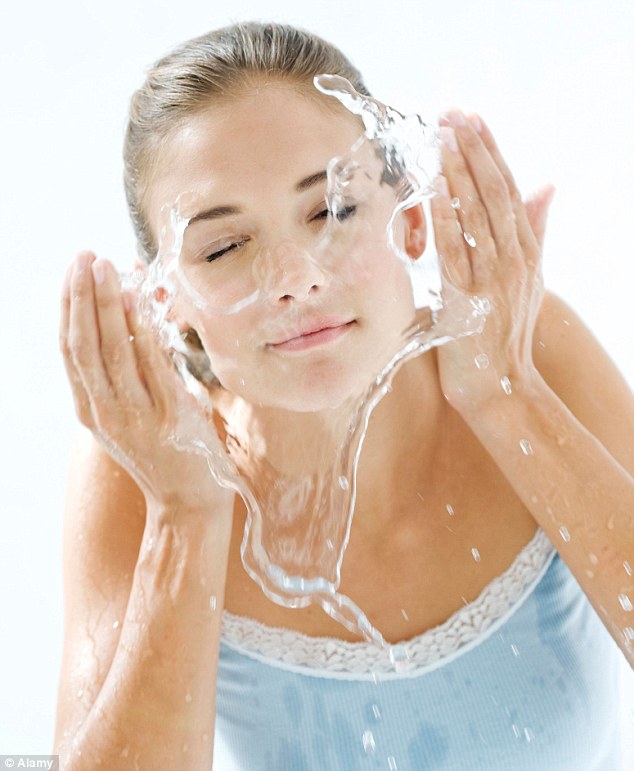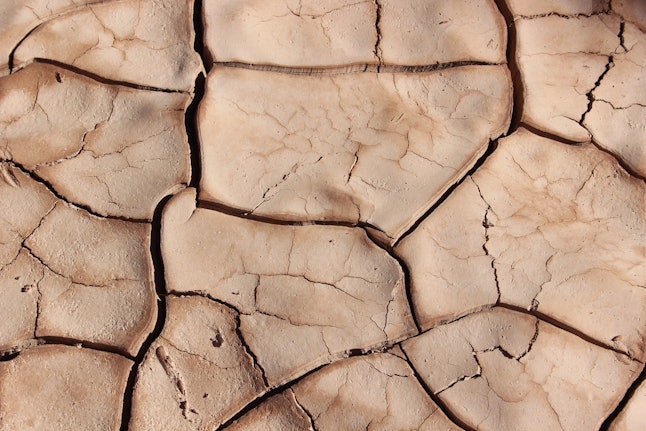via : Knot Me Pretty

We have all, at some point, felt frustrated with the condition of our skin. Dry, flaky, sensitive, too oily, prone to breakouts. Sound familiar?
The interesting fact is that your skin’s health is directly linked to the balance between acidity and alkalinity, which is measured by the pH scale.1
All soaps, lotions, cleansers, and other skin care products have an effect on the pH level of your skin.
How Does pH work?
The pH level of a substance is measured on a scale of 0 to 14: 0 is the most acidic, 14 is the most alkaline, and 7 is neutral, which is the pH of pure water.
The surface of normal adult skin is coated with a combination of sebum, skin’s natural oil, and perspiration. This coating is referred to as the acid mantle, which protects the skin and locks in moisture.2 Normal adult skin is slightly acidic with a pH level in the range of 5.4 – 5.9.1
There is a delicate balance with skin’s pH – when the pH is too alkaline, the skin becomes dry and very sensitive, which may lead to signs of skin aging, such as fine lines and wrinkles.3
What is the pH Level of my Skin?
Normally you can quite easily determine the pH level of your skin, by taking a look at the behavior of your skin. For instance, if your skin is oily and acne-prone it may be overly acidic. If it tends to be dry, sensitive and flaky, it may be too alkaline.
You can buy pH testing strips at your favorite drugstore to test in the comfort of your home. An alternative would be to consult your skin care physician to get a more accurate reading.
So Why Cleanser Instead of Soap?
Soap has a general pH level of between 9 and 10, which can make your skin feel very clean, but is just way too harsh. It removes all natural oils from your skin making the pH level too alkaline.1 This can cause a host of new problems – the skin becomes dry, flaky, and prone to inflammation. This can cause the sebaceous glands to overproduce oil to compensate for the dryness causing clogged pores and breakouts.3 When skin is overly dry and flaky, it can also lead to premature fine lines and wrinkles.
Cleansers are generally at a much lower pH level than soaps and are gentler on your skin
Bottom Line
Avoid harsh soaps on your face, such as bar soaps, which have an alkalinity level between 9 and 10. Use facial cleansers, which have a lower pH level and are specifically designed to cleanse the face.
And on a separate (but important) note: eat a healthy, balanced diet to regulate the pH level of your body.4 Avoid processed foods and eat plenty of fruits and veggies, which will help keep your skin glowing and radiant!
It turns out there’s quite a bit of research and science behind the concept of beauty rest. Sleep is when some of the most important internal — and epidermal — recovery takes place!
While you shouldn’t fully abandon your daytime skin care routine in favor of getting more Zzz’s, there are some easy ways to amp your skin-sleep relationship for morning results.
You can almost immediately tell that getting a poor night of sleep doesn’t do woke-up-like-this wonders for your face. Research even says that one night of poor sleep can cause:
A 2017 study found that two days of sleep restriction negatively affected participant’s perceived attractiveness, health, sleepiness, and trustworthiness.
So, what seems like an overnight issue could transform into something more permanent.
First and foremost, you should understand that sleep is the time when your body repairs itself. This is true for your epidermis as much as it is for your brain or your muscles. During sleep, your skin’s blood flow increases, and the organ rebuilds its collagen and repairs damage from UV exposure, reducing wrinkles and age spots.
Think about it: Your face against rough, drying cotton for one-third of its existence and being exposed to the sun for two unprotected hours could do a number on the appearance and health of your skin. Here’s what you can do to help give your skin a rest.
The best place to start for your skin — and for your overall health — is to get the recommended amount of rest each night.
The results of poor sleep for your skin are numerous and significant, including:
Sometimes you might have an off day but you should average seven to nine hours of sleep. If you’re wondering how to reset your internal clock and catch up on rest, try sleeping in on the weekends by following our three-day fix guide.
You can also track your sleep with a wearable fitness tracker.
We’ve established how sleeping is a surefire way to help your skin repair itself: blood flow increases, collagen is rebuilt, and the muscles in your face relax after a long day.
But going to sleep with a dirty face can also harm the appearance of your skin.
Cleansing your face each night is arguably more important than in the morning — you don’t need to use fancy products or scrub too hard. A gentle cleanser to remove dirt, makeup, and extra oil will do the trick.
You don’t want to give the day’s pore-clogging irritants the chance to sink in and do damage overnight. This can cause:
Washing your face can dry it out and sleeping can also dehydrate skin, especially if you snooze in a low-humidity environment. While staying hydrated by drinking water can help to some extent, what your skin really needs at night is a topical moisturizer.
Again, you don’t need the fanciest product on the market. You just need a thicker cream or oil that can help your skin as you sleep. Another option is to use your day moisturizer and layer petroleum jelly — using clean hands — on top to lock in the moisturize. For a more supercharged product, try an overnight sleeping mask.
It makes sense that the position your face is in while you sleep (for one-third of your day!) matters to your skin.
Sleeping on a rough cotton surface can irritate your skin and compress your face for long hours at a time, resulting in wrinkles. While most wrinkles are caused by the expressions we make while we’re awake, wrinkles on the face and chest can result from sleeping on our stomachs or sides.
An easy solution to this is sleeping on your back — which also has a few other benefits — even if you have to train yourself over time.
If you prefer to sleep on your side, get a skin-friendly pillow. A satin or silk pillow minimizes skin irritation and compression while copper-oxide pillowcases may reduce crow’s-feet and other fine lines.
Elevating your head has been proven to help with snoring, acid reflux, and nasal drip — all issues that can disturb the quality of your sleep, and therefore your skin. In addition, it can help reduce bags and circles under your eyes by improving blood flow and preventing blood from pooling.
Elevating your head while you sleep can be as simple as adding an extra pillow, adding a wedge to your mattress, or even propping the head of your bed by a few inches.
While we do most of our sleeping in the dark, sleeping with your skin directly exposed to the sun in the morning, or during naps, can have a damaging effect on your skin’s health and appearance — not to mention that sleeping in a lighted room can disturb sleep and sleep rhythms.
Getting blackout curtains or making sure that your bed is out of the sun’s direct line can help.

UV rays from the sun are the number-one cause of skin aging. You probably already know this, which is why you regularly use sunscreen in the summer. But what about during the winter months? Do those gray days and thick clouds change your skin care routine?
Winter sun can create lasting damage to your skin.
Even during the cold weather, we’re at risk from ultraviolet radiation in the form of UVA rays. Though UVB radiation decreases, UVA radiation does not and it’s actually these rays that are more responsible for premature aging. They reflect off snow and can pass through glass. They’re not affected by changes in temperature, and can penetrate deeply into the skin, where they may create damage that leads to aging and even increases risk of skin cancer. They’re also more potent at higher altitudes—take note, skiers!
Even just a few minutes of exposure every day over many years can cause noticeable changes in your skin. These include:
To retain more of your youthful complexion, try these tips for protecting your skin from winter sun damage.
Do you have other tips for protecting your skin in winter? Please share them with our readers.

Of course, you likely know how to combat the dry skin once you’ve got it — using methods like slathering the offending area in gallons of high-strength moisturizer — but there are also ways to nip these things in the bud before they get too severe. Arm yourself with expert knowledge so that you can avoid dry skin altogether by deciphering the less obvious causes of dry skin.

Dr. Michael Swann, board certified dermatologist, says that it’s not just heating in your homes that can cause dry skin. “Heated air in our homes, offices, and cars is generally very dry,” he says. “The result is that our skin thickens (the dead layer stays on longer) and can crack in response to the slower turnover and dryer conditions.”

She continues, “While the weather conditions continue, our skin works hard to produce additional oil to moisturize, but for many skin types it is hard to catch up. The best way to prevent uncomfortable dryness is to know when to level up on your moisturizing products, starting early to prevent dryness.”

According to NYC dermatologist, Dr. Joshua Zeichner, it’s a whole other ball game for those suffering with acne.
“The winter time can be especially challenging for acne patients, as many acne drugs can dry out the skin,” he says. “Choose lower concentrations of acne fighters like benzoyl peroxide during the winter time. 2.5% BPO has been shown to be as effective as higher, potentially more irritating concentrations like 5% or even 10%. You can also speak to your dermatologist about non-irritating, effective prescription options, like Aczone gel 7.5% that will not dry your skin out.”


“During the winter the skin dries and dehydrates more intensely because of many reasons including, but not limited to the use of heavy clothing in some cases,” says Dr. Christian Jurist, certified Aesthetic Medicine Specialist, Facial Specialist, and Medical Director of Global Education at Pevonia.

“Our skin does an amazing job at protecting us from the elements. In the winter, our skin needs to be a stronger, thicker barrier from colder conditions. Remember that our skin is responsible for shunting blood away from the skin to keep our internal bodies warm in the winter, “says Dr. Swann.

“Sebaceous glands that are less functional to produce oil and maintain a healthy epidermal barrier,” Dr. Jurist says. In other words, they simply don’t work as well in winter, and therefore can’t keep your skin moisturized.
Now you have a little more insight into why skin gets dry in the winter, so you can put preventative measures into place, or put an end to anything that may be contributing towards drying your skin out. Then, fingers crossed, you can bid good riddance to cracked, sore skin once and for all!
A gold facial is honestly one of the most indulgent spa treatments we can think of. But while they were once a pampering method reserved only for celebrities and ancient royals, these days you’ll find gold facials and gold face masks popping up on high-end spa menus everywhere. Sure, they can be pricey, but sometimes, you just have to spoil yourself. And unlike a bottle of wine, a tub of ice cream, or a night spent vegging out in front of the TV, gold facials are actually good for you.
But what does all that gold actually do? Read on to find out all about how the luxury metal can transform your skin—we promise you’ll never again consider it an extravagance to buy raw cookie dough just for snacking.
Gold facials can differ from spa to spa, but generally they follow a traditional facial format—cleansing, exfoliation, extractions, etc.—but include one of the most decadent add-ons ever invented: a gold face mask. Depending on the technique used, this might involve the aesthetician massaging sheets of 24-karat gold leaf onto your skin. Or, they might coat your face with colloidal gold, a liquid solution with gold nanoparticles suspended in it.
If this whole idea seems to have trended rather suddenly, there’s good reason for that. The gold facial has grown in popularity since 2006, when a Japanese company pioneered a method for helping the metal penetrate surface layers of skin.
Other than giving you a great excuse to take a selfie, what is all that gold doing on your face?
Gold has long been used in Ayurvedic medicine and ancient skincare—Cleopatra may have been a fan—and modern aestheticians stand by its firming and anti-aging benefits. Gold’s antioxidant properties are said to fight off environmental toxins and sun damage. Clients may find their skin feeling softer and more supple thanks to accelerated cell regeneration and elastin production.
Dermatologists, however, caution that some people can have an adverse reaction, particularly those who experience contact dermatitis when wearing jewelry.
Many at-home beauty treatments are also incorporating gold into their list of ingredients. Using one of these in your routine can be a great way to get some of the benefits of gold without breaking the bank.
Shop: www.saloni.pk
Shop: www.saloni.pk
Shop: www.saloni.pk
Shop: www.saloni.pk

What if we told you that letting hundreds of tiny needles penetrate the surface of your skin could change the way it looks forever!? Surely you’re either scoffing or wincing in pain, two of the most natural reactions we’ve noticed when telling friends, family and colleagues about the powers of a derma roller. But, it’s not as quack as it may sound, and in fact, could be the answer to a huge range of skincare concerns you may have been grappling with for a while.
Of course, we’re not asking you to hop straight online and purchase a derma roller without knowing all of the facts, first. Before you get to micro-needling your skin yourself, there are a few things you’ll need to know, including how to maximise efficacy and how to buy the ideal derma roller. Whether you’re a convert or a cynic, keep on reading to find out how you could make a derma roller work for your skin.

A derma roller, AKA a skin needling device, features a cylindrical body attached to a long handle. The cylinder is covered in tons of little needles that individually prick the surface of the skin, creating what are known as ‘micro-injuries’. Simply pick up the handle and roll the body of the device over the skin…well, that’s technically how it works. But, there are a lot of other things to take into consideration before getting rollin’.
We’re not asking you to inflict injury on your complexion for no reason — there are so many benefits to this practice. After micro-injuries are created, skin has to work extra hard to repair the ‘broken’ cells, which in turn accelerates the production of collagen and elastin. These key proteins are produced less effectively as we age, resulting in the formation of wrinkles and fine lines.
Many people are curious about what using a derma roller feels like, and despite the fact that many needles are involved, it’s a lot less painful than you’d think. The thin, short nature of the needles means you’ll barely feel it at all. You may experience slight discomfort or redness after using your derma roller, but at worst, it’ll feel like a mild sunburn.

As a derma roller encourages collagen and elastin production, it can have benefits that include the softening and blurring of physical ageing signs. It also works wonders for loose or thinning skin, both of which are also directly related to these important natural proteins.
Derma rolling is also beneficial for a range of other skin types, including scarred, dehydrated and hyperpigmented. Regular derma rolling has been found to fade acne scars in particular, as these are often quite rooted in the skin’s layers, which the micro-needles are able to reach. Even if you have acne, you can use a derma roller — just ensure you’re not rolling over active pimples, and are sterilising the needles after every use.
Derma rolling also means that the top layer of your skin is shed in the process, encouraging effective skin cell turnover. This works wonders for those experiencing hyperpigmentation in the form of darkened or lightened spots, as shedding away surface layers ensures the new skin isn’t affected by discolouration.
You can even use your derma roller on your under eye area to plump and smooth away bags, and on the lips to encourage an enviable pout.
If we’ve sold you on all the benefits of a derma roller, you’re probably excited to get your hands on one. But, it’s not that simple — not all derma rollers were created equal! It can actually be quite dangerous for the skin to use the wrong one, so here are a few things to look out for.
First, ensure your product is entirely reputable. No paying a few bucks off a cheapie site, because at the end of the day, your skin health is seriously important! Generally, you’ll be looking at an investment between $30 and $100 for a quality derma roller, depending on the brand. Don’t splash too much cash, but beware that anything that seems too good to be true probably is.
Another aspect you’ll want to look out for is the needle’s size and thickness. Anything above 0.3mm shouldn’t be used at home, as it can cause damage quite easily when not wielded correctly (AKA, by one of the pros). Opt for an 0.2 or 0.25mm sized needle. You’ll also want to ensure it’s made of a quality material, such as surgical-grade steel or titanium.
To prep skin for using a derma roller, first ensure it’s thoroughly clean by using a cleanser. We recommend double cleansing to truly lift away any dirt and imperfections, especially those from a little deeper in the pores. Next up is an exfoliant or chemical peel, which will help smooth away any excess dead skin and give your skin the perfect canvas for derma rolling.
Then, it’s time to slick on your favourite serum (although, it’s important to know your stuff — more on that later). Apply as you usually would, and then begin rolling across the face, working in all directions. Make sure you’re a little lighter around the under eye area and on the lips, or in any areas where your skin is typically delicate.
Apply a second layer of your serum once you’re done rolling, and that’s it! You’ve successfully derma rolled for the first time. You can repeat this practice a few times a week at the most, but it’s also totally fine to leave it as a once a month or fortnight kinda deal — just do what your skin seems to prefer.

Using a serum is an important part of derma rolling, as the small injuries you’ve made to the skin allow for deeper and more effective absorption of your product of choice. Thus, it’s an excellent way to ensure key vitamins, minerals and antioxidants reach the innermost layers of your skin.
However, there are definitely serums that you shouldn’t use with a derma roller. Anything too potent isn’t designed to reach that deeply into the skin, and so, should be left for those days when you aren’t pricking your face with teeny needles. We’re talking retinol, Vitamin C and anything else that can leave skin feeling raw or peeling a bit. Combining anything of that kind of potency is sure to turn your derma rolling dream into a nightmare, so leave the hard stuff to the pros.
Instead, here are some key serums you can use with your derma roller. Hyaluronic acid-based serums are the perfect choice for those with dry or ageing skin, as they work to grab onto moisture molecules and lock them into the skin. Our pick is the NIOD Multi-Molecular Hyaluronic Complex.
The asap Radiance Serum is another go-to for a whole range of skin types, but hyperpigmented or dull in particular, as it uses AHAs and botanical extracts to boost your glow. Acne-prone skin types will enjoy the Alpha-H Vitamin B with Copper Peptide Serum, as Vitamin B (AKA niacinamide) is a key blemish buster, and also works on scarring, fine lines, dark spots and more.
Have you ever tried a derma roller or skin needling treatments? Let us know your experiences over on Facebook
Can glutathione pills whiten your skin? Does it work?
The answer is….it does work for some people but not all. I’m honestly not a fan of glutathione pills because when I took it before, it didn’t work for me. I gave it a fair amount of time (about 4 months) and it didn’t change my skin tone at all. I got better results using topical whitening products (soap, lotion, cream) and when I took this kind whitening supplement (read about it here) everyday. I can honestly say that it whitened my skin about two shades.
A little information about glutathione:
I know that most of you probably know that glutathione is a tripeptide, which means it contains three amino acids namely L-cysteine, L-glutamic acid, and L-glycine. I’m not going to write a lot about glutathione’s history because I am more focused on its effect in skin whitening.
For those of you who still wants to take glutathione pills, here’s what do you need to look for before buying it:
You have to look for the “reduced” glutathione form. The label or the ingredients panel should say “L-Glutathione Reduced.” Why do you need the “reduced” form? Because “reduced” means that this is the kind of glutathione that does not oxidize quickly after taking it. Oxidize or oxidation means that it loses its effectiveness after taking or using it. It’s important to keep in mind that glutathione does oxidize after taking it orally. But when you buy the “reduced” form, you’re basically taking the kind of pills that have a much better effect because it doesn’t lose its effectivness right away after hitting your bloodstream unlike the regular form of glutathione.
What can you do to see the whitening results a lot faster:
Take your glutathione pills with a high dose of Vitamin C. Since glutathione oxidizes, you need to take a “back up” supplement and your best choice is Vitamin C. Vitamin C is a very good antioxidant and has a skin brightening effect as well. So you’re basically getting skin whitening plus skin brightening at the same time! You’re going to have a whiter and glowing skin just like a celeb in no time!
How much glutathione and Vitamin C should you take:
You have to take a minimum of 500 mg of glutathione per day to see skin whitening effect, however, I would take twice this amount of more due to the fact that it has the tendency to oxidize.
For example, if you’re taking 1000 mg of glutathione, you need to take twice the amount of Vitamin C. This means that if you’re taking 1000 mg of glutathione, then you must take 2000 mg of Vitamin C to guarantee skin whitening. I know it sounds a lot but don’t worry – this isn’t toxic. Why? Because Vitamin C and glutathione are both water soluble. There are no studies that shows Vitamin C or glutathione overdose.
(Friendly reminder: this is not a medical advice. Please contact your physician first before taking any kind of supplements.)
What brand of glutathione and Vitamin C should you buy:
I would suggest to stick with USA-made brand of glutathione pills. Why? Because if the glutathione supplement is made in the US, this means that if the product claims to have 500mg of glutathione, then this is more than likely 100% correct. The USFDA requires all manufacturers to indicate the exact amount of ingredients per capsule. There is no way to get around this policy in the States.
Also, when shopping for glutathione pills, please make sure that you’re getting 1 serving per capsule of at least 500 mg of Reduced L-Glutathione. I’ve seen many companies who promote that their glutathione pills have 800 mg of glutathione in the front of their labels but it turns out that this is actually for 2 servings. This means that you’re only getting 400 mg of glutathione per capsule – don’t be fooled by this marketing tactic.
There are a lot of glutathione supplement brands that are being marketed both online and in store and I’m still searching for the best brand of glutathione until now. I will update you guys when I find the right one.
How long before you see skin whitening results after taking glutathione and Vitamin C pills:
This really depends on your body. I can’t tell you when you’re going to see results because everyone is different. One thing though – please be diligent. You have to keep on taking the pills everyday, otherwise, you’re not going to see any results at all. There are reports that the average time before seeing results is about 12-16 weeks (3-4 months) of continuous use – but again, this isn’t the case for everyone. Some of you will probably see the results faster and some needs to take it for several months before seeing any results.
Is there an alternative to glutathione in terms or whitening the skin?
Absolutely. Here’s the article.
via :

As the days start to get shorter and the weather finally becomes brisker, thus signifying fall’s return, you may begin to notice some not-so-fun changes in your skin. They might be similar to the symptoms that can arise when winter turns to spring, and when summer is nigh. For instance, your skin might feel tight or appear drier than usual, or if you’re acne-prone, maybe your pimples are more inflamed than ever. According to dermatologists, these adverse changes in your skin can more than likely be attributed to the transition of seasons.
While there’s nothing you can do about seasonal shifts (aside from moving somewhere with a milder climate), that doesn’t mean your skin has to suffer the consequences.
what measures you can take to ensure your complexion stays in tip-top shape. Follow these advice and you’ll be one step closer to having happy skin — no matter what season it is.
As the days start to get shorter and the weather finally becomes brisker, thus signifying fall’s return, you may begin to notice some not-so-fun changes in your skin. They might be similar to the symptoms that can arise when winter turns to spring, and when summer is nigh. For instance, your skin might feel tight or appear drier than usual, or if you’re acne-prone, maybe your pimples are more inflamed than ever. According to dermatologists, these adverse changes in your skin can more than likely be attributed to the transition of seasons.
While there’s nothing you can do about seasonal shifts (aside from moving somewhere with a milder climate), that doesn’t mean your skin has to suffer the consequences. Allure spoke with several dermatologists who revealed why skin tends to freak out during these phases, as well as what measures you can take to ensure your complexion stays in tip-top shape. Follow their advice and you’ll be one step closer to having happy skin — no matter what season it is.
From warm to cold weather:
Put simply: The skin likes consistency, so when factors, like weather, change on a dime, it’s like a shock to the system. “Rapid fluctuations in weather can take its toll on our skin as it adjusts to the new environment,” explains New York City-based dermatologist Joshua Zeichner. “For example, as we shift from summer to fall, temperature and humidity will drop quickly, so the skin will have to work harder to maintain adequate hydration as cold weather and wind start to kick in.”
Zeichner says this can lead to cracks in the outer skin layer, loss of hydration, and inflammation — all of which can seriously impact the overall state of your skin health.
Dermatologist and founder of SmarterSkin Dermatology, Sejal Shah, adds that these symptoms occur because the skin barrier becomes disrupted during this period, making it more susceptible to inflammation and irritation.
It’s not the temperature alone that causes these skin woes, either. Shari Marchbein, a dermatologist and clinical assistant professor of dermatology at New York University School of Medicine, says it’s the sudden switch in weather, coupled with subsequent lifestyle changes people make as it gets cooler, such as taking hot showers and using central heat in homes, that contributes to the aforementioned dryness and inflammation associated with this transitional period.
From cold to warm weather:
On the flip side, as the weather gets warmer and humidity is heightened, the skin has to adapt yet again: “As skin starts to adjust to warm or hot weather and humid air, this often means feeling greasy and heavy as more oil gets trapped on the surface of the skin,” says Zeichner. “It’s essentially the exact opposite of what occurs from summer to fall or fall to winter.”
Bottom line: If the seasons are transitioning and you notice your skin is taking a turn for the worse, make an appointment with your dermatologist, as they can recommend specific products or treatments that will help your skin regulate itself and get back to a harmonious state.
There are a few things you can do. For starters, during the evolution from summer to fall, and fall to winter, which is when humidity is much lower, Marchbein highly recommends limiting showers to no more than five minutes and avoiding hot water at all costs. She also recommends using a gentle, nourishing body wash like Dove’s Deep Moisture and following up with a thicker cream than you would use during the summer months.
“Apply moisturizer within 60 seconds of coming out of the shower and look for ingredients like glycerin, ceramides and hyaluronic acid,” she adds. The same can be applied to your complexion care, too.
Additionally, Zeichner suggests implementing a hydrating serum into your regimen, such as the Clarins Double Serum, which contains soothing turmeric, squalane, and avocado oil. He also says you should never skip out on moisturizer (like some might in the summer when the skin is producing more sebum), and emphasizes the importance of using a creamy cleanser during the cooler months.
In the hot and humid months, however, Zeichner suggests switching to an oil-removing cleanser to help control excess sebum. “If you feel that you need a deeper clean, look for products that contain salicylic acid, like in a light moisturizer, lotion or a gel,” he adds. “And, of course, be extra diligent using your sunscreen.” (Here are 22 excellent moisturizers that fight oil and won’t clog your skin.)
All of this to say, while the weather is uncontrollable, skin health is not. Pay attention to the state of your skin and switch up your routine as the seasons change. If you’re noticing persistent concerns, visit your dermatologist to determine a plan of action together.
Your feet are on display this time of year, but it’s hard to keep them looking their best when the weather’s warm: Exposure to the sun and hot surfaces like sand and concrete can leave your poor dogs dry and rough. Here’s how to protect them from the elements so they stay picture-perfect for the entire season (because you never know when you’ll want to Instagram your pedi).
Exfoliate At Least Once A Week
“This will help you get rid of surface dry skin cells, making them look and feel smoother,” says Kristen Murphy, Spa Manager at the Woodmark Hotel’s Still Spa. Plus, your moisturizer will be more effective when you slough off flaky skin first. Some great budget foot scrubs to try include Tree Hut’s Peppermint & Sugar Exfoliating Foot Scrub ($4.88, walmart.com) or Kiss My Face Peppermint Foot Scrub ($8.95, kissmyface.com). For dryer skin, opt for a sugar scrub instead of a salt-based scrub; although salt detoxifies and draws out impurities, it can also be dehydrating.
Avoid Soaking Feet
Contrary to what you might think, soaking can further dehydrate already-dry feet, says Murphy. So instead of soaking your tootsies, apply a sugar scrub directly onto dry skin, and wipe it off with a moistened towel.
Keep a Pumice Stone in Your Shower
Celebrity manicurist Jin Soon Choi, founder of the JINsoon Nail Lacquer line and Jin Soon Hand & Foot Spas in New York City, grew up in a small village in South Korea where foot-care products weren’t available. “We would go to the river and find a textured stone, and we would scrub our callouses and feet with the stone,” she says. “This really worked.” Of course, you don’t have to search for your own stone since commercially available pumice stones are available. Use one daily or once every other day; just make sure to apply less pressure to soft skin and more to callouses when giving your feet a scrub-down.
Do Some Heavy-Duty Moisturizing
Your heels are prone to over-use—and as a result, they tend to dry out more easily than the rest of your foot, says Choi. The heel is also protected by thicker skin, which means that it’s less penetrable and it’ll take a little more effort to lock moisture in. Apply a lotion or oil immediately after you shower to retain the moisture your feet have already soaked up. For even better results, reapply a moisturizer right before bed. Borghese Piedi Vitale Therapeutic Foot Crème ($21.50, borghese.com) or Neutrogena Foot Cream ($4.99, neutrogena.com) are both good bets.
Don’t Forget to Apply Sunscreen
Lots of people neglect to apply a good SPF to their feet, but don’t make this big mistake. Not only does the skin on your tootsies need protection, but nails are made of protein and are therefore as vulnerable as your skin. “Cuticles serve a purpose,” says Barbara Hershfelt, director of sales and marketing for Cutex. “They seal in moisture and protect new nail growth as it emerges from the base of the nail.” Sun, wind, and sand can dry cuticles and nail folds (the areas of skin that frame your nails), which is bad for nail growth. You can avoid these issues by being diligent with your sunscreen routine.
Eat Foot-Friendly Foods
Believe it or not, some foods can cause your feet to swell and become bloated. Foods high in salt are the most likely culprits, says Carolyn Dean, M.D., a member of the medical advisory board for the nonprofit Nutritional Magnesium Association. To keep your feet looking great, avoid packaged foods, which are heavily salted. Sugars can also cause foot puffiness, so you’ll want to minimize your intake of that, too, says Dean.
MORE: 5 Foods That Have More Sugar Than a Candy Bar
Let Toes Breathe
Since nails are a living part of your anatomy, they need a break to “breathe” from time to time so they can continue healthy growth patterns and rid themselves of chemical residue, says Choi, who recommends a break from nail polish about once a month for a few days to a week. This can help prevent discoloration—particularly if you like to use dark-colored nail polishes—and keep your pedi looking pretty.